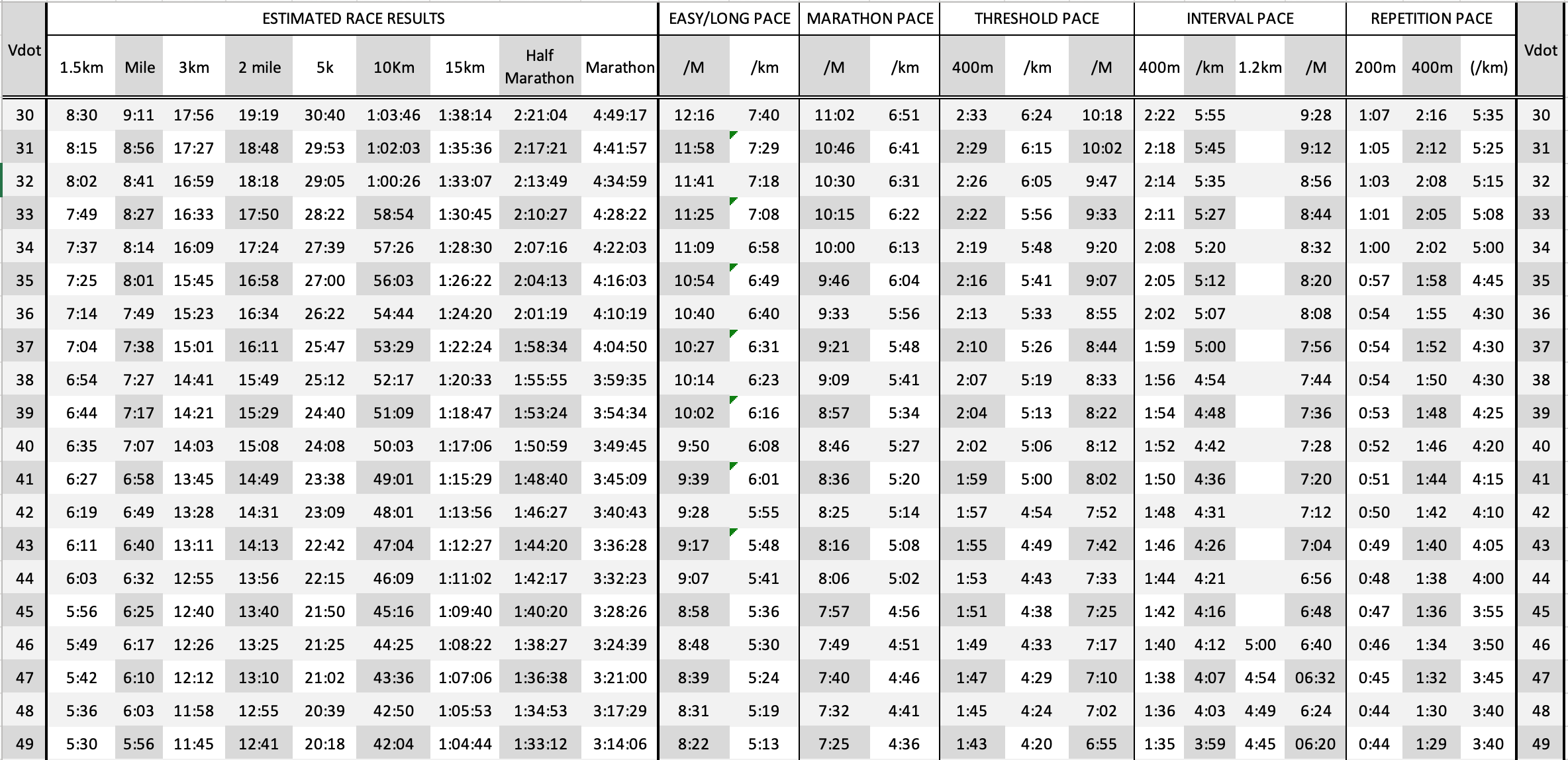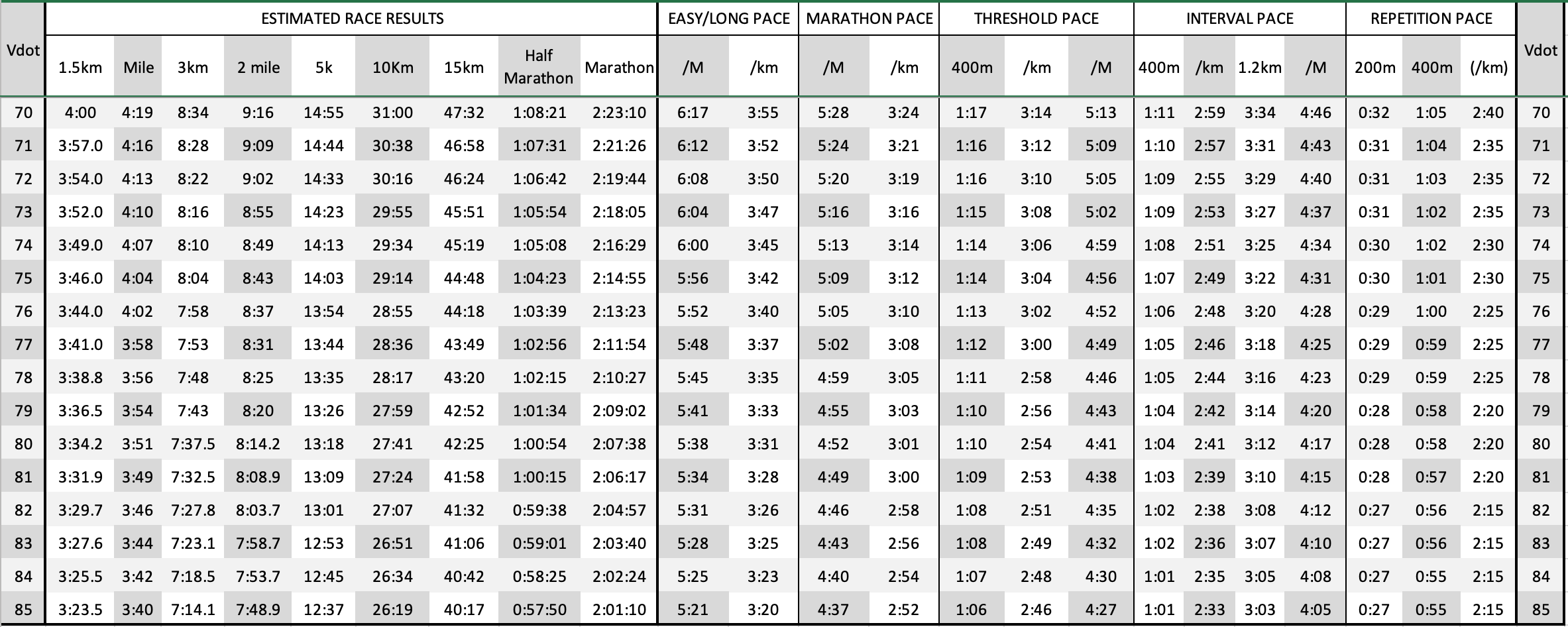Run Testing - Calculating your VDOT Pace and Lactate Threshold Heart Rate
You may have heard the term VDOT banded around quite often in triathlon and running circles but it is a term that is often misunderstood and sometimes used incorrectly. This blog will seek to dispell any myths around what VDOT is and how it should be used as there is no questioning that it is a very useful training concept.
To develop an efficient running economy, athletes must look at two important components; technique and conditioning. In all Tri Training Harder running sessions, we talk about running at certain intensities in order for each session to have it's intended purpose. To ensure that these intensities are accurately adhered to, an athlete must have an understanding of how fast they are running relative to what they can sustain. This requires a scale to give the athlete bounds to stay within. To make the scale useful for each and every athlete, that athlete must know where his or her fitness level lies on the scale. This is where the VDOT score comes in.
However, let's rewind a few steps for now and discover exactly what a VDOT score is. Then we will discuss how to work out our own VDOT scores and then figure out how this determines our personal training intensity zones.
What is VDOT and Lactate Threshold Heart Rate?
VDOT is the over-arching name for VO2 Max values (maximum oxygen uptake capacity), a term coined by Jack Daniels. Ultimately it is a method of determining an athlete's training intensity using recent test or race results. Lactate Threshold Heart Rate (LTHR) is a term used to describe Lactate Threshold: the point at which blood lactate accumulates and lactate clearance is unable to keep up with lactate production. Your LTHR can be found by completing a VDOT test. By determining lactate threshold through conducting a VDOT test, it is possible to deduce the accurate intensities (paces) at which individuals should train at. For endurance athletes, it is important to work at the correct intensities for the session you are carrying out to reap the most benefit. For example, running at Threshold Intensity can improve performance at lactate threshold over time by stressing the correct systems in the body.
What happens if I don't use VDOT Intensities or Heart Rate Data?
We understand that some athletes prefer not to use either heart rate or VDOT intensities as a method for measuring their training. For example, many people prefer to use feel. That is fine, but as you can imagine when it comes to working with a coach remotely, it is always easiest to have some sort of data to work with which can improve the quality of feedback.
How do I calculate my VDOT score and LTHR?
The test is very simple to complete and simply requires a running track (a flat-surfaced road surface can also be used but it isn't the most ideal). All you need to do is carry out a 3.2km (2 miles) time trial or any other race (a 5km Park run is a good option!). You should aim to run consistent splits for every lap or, run at negative splits. By the end of the time trial, you should feel like you cannot go for any longer at that intensity. Ensure that you complete a good warm-up of at least 2km before carrying out the time trial so that your systems are sparked and ready to go.
Calculating Your Own Correct Training Intensities
Find your VDOT score using your total time for the 3.2km (2 mile) VDOT test in the table below. After determining your VDOT score you can then use this to find your training intensities in the table Training Intensities corresponding to VDOT Score.
Training Intensities
Easy Intensity - 69-83% LTHR. Used for recovery runs, long runs, warm-ups and cooldowns. It is a pace which promotes aerobic efficiency and aids active recovery and its purpose is to build a base for more intense sessions.
Marathon Intensity - 84-94% LTHR. Used for long runs to build aerobic endurance. If you are looking to compete in a marathon then this would be the intensity you would look to run at, if you are competing in an Ironman then you would be running slower than marathon intensity.
Threshold Intensity - 95-105% LTHR. This intensity is most typically conducted as a Threshold run with the aim being to raise lactate threshold. You should be able to maintain this intensity for up to an hour and it should feel comfortably hard.
Interval Intensity - 106%> LTHR. This intensity stresses VO2 Max (maximum oxygen uptake) and is usually completed as intervals in a session with recovery in between. The intensity can be maintained for up to 12 minutes during a race but no more.
Repetition Intensity - 106%> LTHR. This intensity aims to promote improved run speed and economy. It is performed as intervals and requires adequate recovery between intervals. It should only be a maximum of 5% of your weekly mileage.
For each intensity, you will also have a pace per kilometre or mile which is the pace you should run at on flat terrain. For example, on flat terrain, the intensity will equal your pace as determined by your VDOT, e.g. Threshold Intensity = Threshold Pace. When completing a run on undulating terrain, your average pace should be very close to the pace you are aiming to run at eg. Marathon Pace even though you may not hit your pace at all points throughout the run. You should ensure that the training intensity determined by the percentage of LTHR and rate of perceived exertion remains constant throughout.
VDOT Tables: Estimated race results and corresponding paces
Heart Rate
Provide all information in BPM. You can work your Lactate Threshold Heart Rate out by taking 95% of your peak 20 minute heart rate or, looking at your maximum hart rate held for one hour. The percentages below help describe it with a descriptor.
Level 1 (L1) – Walking/Jog, 0-68% LTHR, 0-2 RPE
Level 2 (L2) – Easy pace, 69-83% LTHR, 2-3 RPE
Level 3 (L3) – Marathon pace, 84-94% LTHR, 3-4 RPE
Level 4 (L4) – Threshold pace, 95-105% LTHR, 4-5 RPE
Level 5 (L5) – Interval pace, 106%< LTHR, 6-7 RPE
Level 6 (L6) – Repetition pace, 106%< LTHR, 7-10 RPE
Level 7 (L7) – Max Effort
Race Intensities:
Super Sprint – Super Sprint pace 106-110% LTHR, 6 RPE;
Sprint – Sprint pace 102-106% LTHR, 5 RPE;
Olympic – Olympic pace 97-101% LTHR, 4.5 RPE;
Half Ironman – Half Ironman pace 89-91% LTHR, 3.5 RPE;
Ironman – Ironman pace 78-84% LTHR, 2.5-3 RPE;
Double Ironman – Double Ironman Pace 68-75% LTHR, 2-2.5 RPE
We’re here to help
Tri Training Harder are one of the leading Triathlon coaching providers in the UK, using our wealth of experience to unite scientific and technological research with already well-established and successful best practices, to create a formula for triathlon and endurance coaching that works.
The result is an honest, dynamic, yet simple new way of constructing an athlete’s training to allow them to reach their potential.
If you’re planning your next season, just starting out in the sport or are looking for extra guidance at the very top end of the field, we are here to help, and our coaches would be delighted to hear from you. You can contact us via the website, and one of the team will be in touch.



